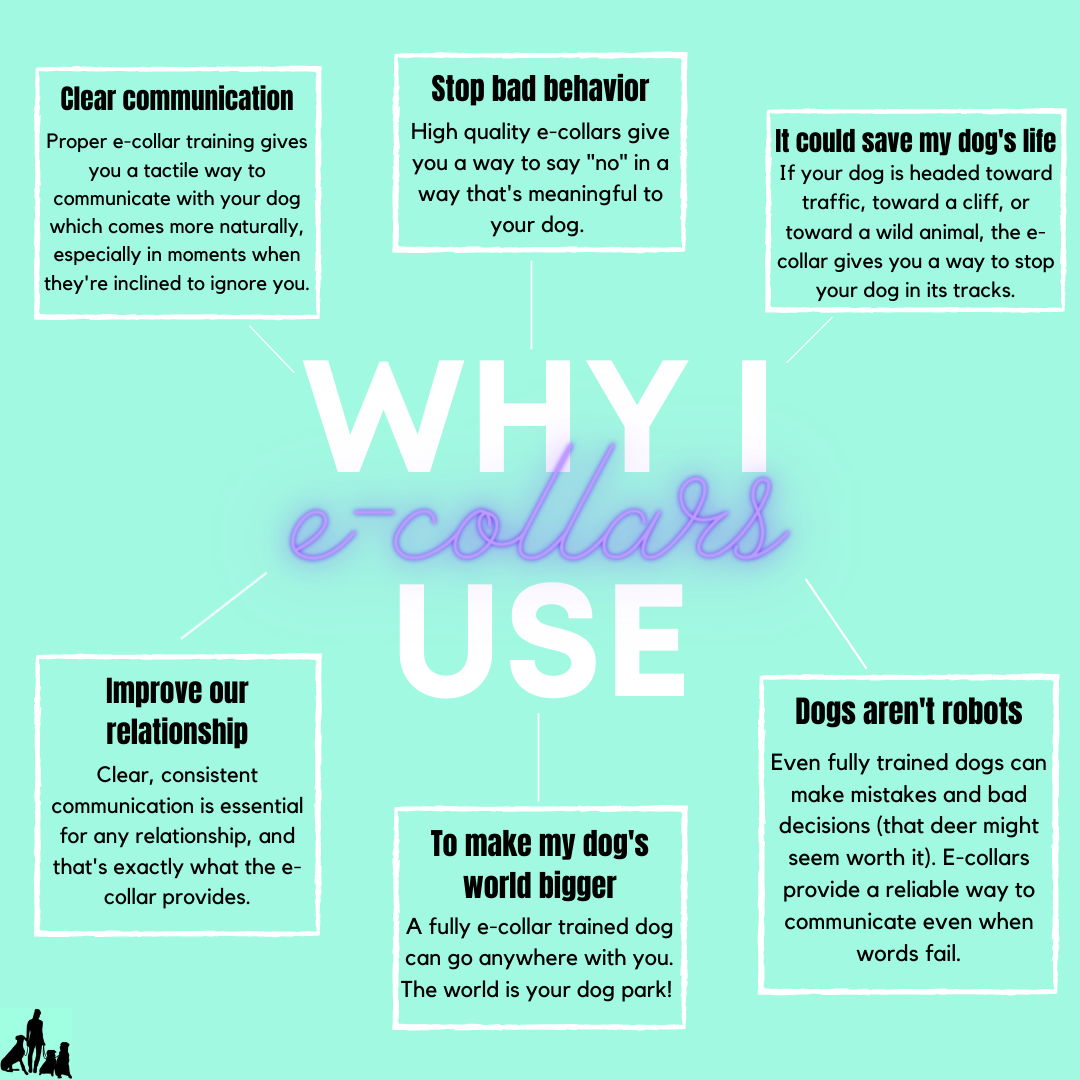With the Petco post circulating about “shock collars” I felt it was appropriate to touch on why I choose to train dogs with e-collars. If you didn’t see the Petco post yet, they announced that they’ll no longer be selling shock collars that are controlled via remote. This has provoked a collective eye roll from balanced dog trainers around the world, but it has also caused some clients to feel a bit of confusion and even shame. If you’re in that latter category, hold your head high—and keep reading. :)
E-collar vs Shock Collar
Before we begin, I suppose it would be helpful to touch on the difference between an “e-collar” and a “shock collar.” The term e-collar refers to an electronic collar that is controlled by a remote—the remote is an important distinction because some bark collars are also electronic but they are not controlled via remote (those are typically referred to as “bark collars” or “no-bark collars”). The term shock collar technically refers to the same thing but is typically used in a derogatory manner. Some balanced dog trainers have made an attempt to reclaim the term “shock collar” but “e-collar” is still the most commonly used term.
Quality is important!
Okay, first thing’s first: I’m glad Petco is no longer selling their crappy shock collars! Petco, like many pet retailers, sold low quality e-collars. E-collars are definitely a product where quality absolutely counts. High quality e-collars like the ones I and most of my colleagues use have 100+ levels, which means you can dial into the exact level required to communicate with your dog in any given moment. Low quality, cheap ass e-collars, on the other hand, have very few levels. Here’s the problem: if a level 3 isn’t cutting it, you have to go up to a level 4. On a high quality e-collar this is a very small shift, but on a low quality e-collar dialing from a 3 to a 4 is a jump—and can be very alarming for the dog. Some people argue that the cheap e-collars deserve the term “shock collar” as they’re very shocking for the dog, and I don’t disagree. Quality matters and frankly, those pieces of junk that Petco used to sell should never have been on the market.
What does it feel like?
At this point you might be wondering “But is it okay to shock your dog at all, even if it’s a low level?” Let’s explain what an e-collar feels like. For most folks, the only point of reference they have for a “shock” is something that’s jarring and painful—messing with wiring and getting an accidental jolt, touching an electric fence used for livestock, etc.—and they assume this is what an e-collar is like. However, this is not the reality of e-collars! High quality e-collars utilize the same technology that’s used in a TENS unit; it’s a muscle stimulator. At low levels, this is a weird tapping sensation that feels kind of like a tap-tap-tap on the shoulder. The reason why this is such a fabulous way to communicate with your dog is because it’s a tactile experience (as opposed to the auditory experience of a verbal command). Tactile methods of communication are more natural for your dog and can get through to your dog in moments when they’re liable to ignore your verbal command. If you’ve ever called your dog and he’s completely blown you off, you can appreciate the ability to get his attention with the e-collar! The beauty of e-collar training is you can communicate in any scenario. Now, that doesn’t mean that dogs come with some kind of intuitive knowledge of the e-collar—you still have to teach them what to do when they feel that sensation, and this is where training comes in. E-collars must be combined with thorough, quality dog training in order for that communication to make sense to your dog. You can’t just put the collar on and start pushing buttons (please don’t do that).
What good are the high levels?
Now, at higher levels the e-collar can of course be uncomfortable, but that’s not a bad thing either. In fact, that can be a LIFE SAVER. The higher levels of the e-collar are used to stop your dog from doing something he isn’t supposed to do. Running toward traffic? Toward a wild animal? Toward a cliff? Toward an unfriendly dog? The upper levels of the e-collar can stop your dog in his tracks, no leash required. How many other training tools do you know of that can do that? You might say “Well if a dog is fully trained then he should respond to your verbal commands and you shouldn’t need any other tools!” Ah, but dogs are not robots, are they? Even fully trained dogs can make mistakes, get distracted and caught up in the moment, or make bad choices (maybe that deer in the woods seemed worth it). The e-collar gives you a way to communicate with your dog in those moments, and I don’t care how well trained your dog is—there will always be those moments! It is no exaggeration to say that the e-collar could save your dog’s life.
A quality training tool
So, why do I use the e-collar? Because high quality e-collars combined with proper e-collar training provide a method of communication that is not inherently uncomfortable or alarming, but that is capable of getting through to my dog no matter what is going on around us—and it does all this without any harm to the dog. It is a complete and total game changer. Period.
If you have an e-collar trained dog, I encourage you to use your e-collar with pride! There will always be folks who judge our decisions and aren’t willing to consider new information, but don’t let them stop you from doing what you know is best for your dog. You do you, and do it proudly!


